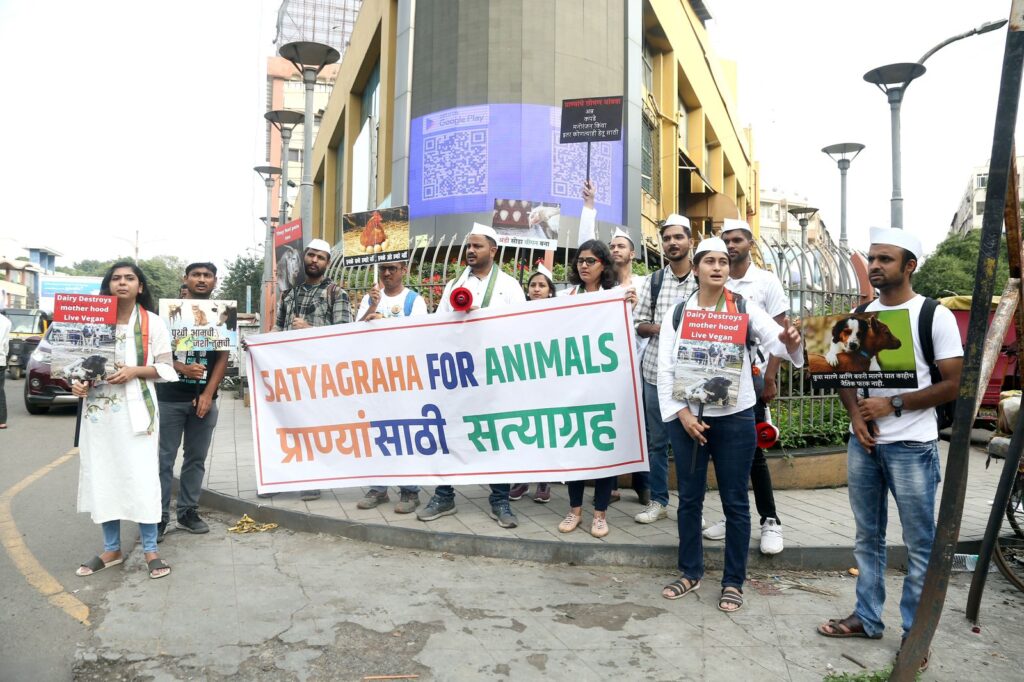
On the occasion of Gandhi Jayanti, animal rights activists marched in Pune, drawing attention to the unjust use of countless animals and promoting veganism through a program called “Satyagraha 2.0.”
Participation in this program was observed from more than 10 cities, making it a peaceful, educational demonstration aimed at reviving the principles of non-violence in remembrance of animals exploited for food, clothing, entertainment, scientific experiments, and more.
Participants fasted for 12 hours and engaged with hundreds of pedestrians during a 10-kilometer walk. This campaign, conducted by Simba Animal Save foundation with the support of the Vegan India Movement (VIM), was in its second year.

At the event site, people read poems, delivered speeches, sang songs about animal rights, and showed videos depicting the plight of animals in various industries.
This year, organizers focused on two sectors that are rarely discussed from an animal perspective – the dairy and egg industries.
Core team member Divya says, “The use of dairy has become so normalized that we hardly question it. We rarely think for a moment about where milk comes from, how it is produced, and who it is for. These fundamental questions point to the core issues of the dairy industry – that cow’s milk is not meant for us. People forget that cows, like mothers, only produce milk for their offspring. The male calves are considered useless and are either killed or sold for meat. The egg industry is equally cruel. Hens are kept in appalling conditions in cages and forced to lay hundreds of eggs in a year when naturally they lay around 15. The process starts with hatcheries where male chicks are culled based on their sex. Male chicks are considered waste and are either ground up alive or disposed of in other ways. Most of us are unaware of these standard practices and harbor the misconception that there is no cruelty in eggs and milk.”
Another organizer, Twinkle, shares, “I have visited several dairies and farms and have had conversations with people from all walks of life about this issue. A misconception runs deep that cows and buffaloes give milk throughout their lives, and what we consume is just the surplus. This perpetuates the cycle, where female animals are kept perpetually pregnant, and later, male calves are sold or killed once they are just 6-8 years old. Bulls are mercilessly exploited for semen collection for years and then discarded. The dairy industry supports the beef and leather industries.”

A participant named Rajesh says, “All industries involved in meat production, whether it’s chicken, fish, goats, cows, or pigs, kill these animals as a part of their natural life cycle. Imagine the terror of the moment when they see the butcher’s queue and witness what is being done to their fellow beings. We perceive some animals through tinted glasses. Some are considered companions, while others are seen as food. This is a form of speciesism, and this is what we are trying to expose through our efforts. A cow, a goat, or a chicken can feel the same pain or joy that a dog or a cat can.”
Mayur, another participant, concludes, “I encourage everyone to see this information and ask themselves if it’s right. Would we want to be in their place? This is a vicious cycle that is a complete violation of their rights, which we contribute to with every sip of tea, bite of meat, or piece of cheese. Similar gruesome practices exist in every animal industry. These sentient beings need to be acknowledged in all these industries, and it should also be recognized that they are not products. They are living beings that have been unjustly deprived of their freedom for far too long.”






